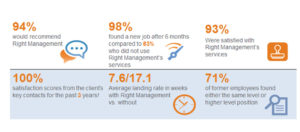The organizational benefits of implementing a comprehensive workforce career management strategy.
Having a comprehensive workforce career management strategy and providing career development opportunities to enhance workforce agility is quickly being recognized as a key strategic focus for organizations across the globe. The digitization of the workforce means the key skills and qualities needed for organizational success have changed (and continue to change) at a rapid pace, while research has predicted that the pandemic will cost the equivalent of 100 million full-time jobs worldwide this year.
Many businesses are now identifying skill-gaps within their workforce and are increasing the rate at which they’re looking to hire new employees. The latest ManpowerGroup Employment Outlook Survey found that hiring intentions of businesses have increased by 13 percentage points compared to the previous quarter – an intention shared by organizations worldwide – while the latest ONS data found a monthly increase of 197,000 pay rolled workers between April and May this year, the highest rise since records began in 2014.
But with so many companies mass hiring at the same time, the pool of talent available in the market is dwindling, resulting in the highest talent shortage for 15 years.
The Talent Struggles for Employers
Research found that businesses could be set to face the impact of a 24-billion-dollar talent exodus – as lack of career progression, insufficient appreciation for work and poor management are driving 4 in 10 employees to consider changing roles. In addition, McKinsey found that even pre-pandemic, 82% of companies struggled to recruit top talent; while only 7% of those who did so felt capable of retaining it. And the impact of Covid-19 has only worked to exacerbate this issue.
ManpowerGroup’s Talent Shortage Survey reports that 69% of global businesses are unable to recruit the skilled individuals they need for success; while 28% of those surveyed in the City & Guilds Group’s Skills Index Report cite a mismatch between the skills they’re looking for and those available through education. This may help to explain why graduates who spent the pandemic gaining work experience – stacking shelves, working as delivery drivers or volunteering – are being viewed as far more employable than those who stayed in education.
So, with competition for talent so high, and the skills many employers are looking for seemingly scarce, the importance of investing in existing talent becomes more important than ever.
Why Workforce Career Management is Important
Without providing employees with the ability to develop skills and a resilience to change, organizations will struggle to attract and retain the talent needed for success in the new reality – especially with 60% of employees planning a career change because of the pandemic. A workforce career management strategy first maps the organization’s existing talent, generating a skills map to identify gaps and growth opportunities, and then develops a culture of ongoing learning and development, with opportunities to help enhance and future-proof employees at all levels. And it’s through doing so that organizations can more easily retain talent.
82% of L&D professionals agree that employees with access to ongoing learning opportunities are more likely to find new roles within their organization, as opposed to leaving the business. And when you combine this with the 60% of employees who believe that learning makes them more adaptable to change, the fact that 64% of workers haven’t received any training in the past year becomes even more of a concern for employers – especially considering LinkedIn found that access to learning and development opportunities has a direct correlation with increased employee engagement and loyalty.
Learning and upskilling enables employees to perform better in their current role and identify alternative career opportunities within their organization. LinkedIn research found that employees and managers who have the room to learn and grow are 3.5x more likely to be happy and engaged, and 3.3x more willing to stay loyal to their organization. So it’s no surprise that more than a third of businesses have increased their investment in learning technology in the last 12 months – with 7 in 10 organizations reporting an increase in the use of digital learning across their workforce.
But digital learning alone is not enough – a robust Workforce Career Management strategy also takes into account the importance of self-reflection, career conversations and peer-to-peer learning. This encompasses career coaching, workshops and the chance for employees to take the time to reflect on their career highlights, strengths, development areas and future goals – and to align these with the needs of the organization.
As employees continue to recognize the need for personal upskilling and growth in order to stay relevant in a changed world of work, leaders are understanding that without supporting the ongoing development of their workforce, they’re likely to lose key talent and find themselves unable to replace it.
By providing career management support, such as career coaching, mentoring and self-awareness activities, businesses are better equipped to retain and attract talent needed for future success.





